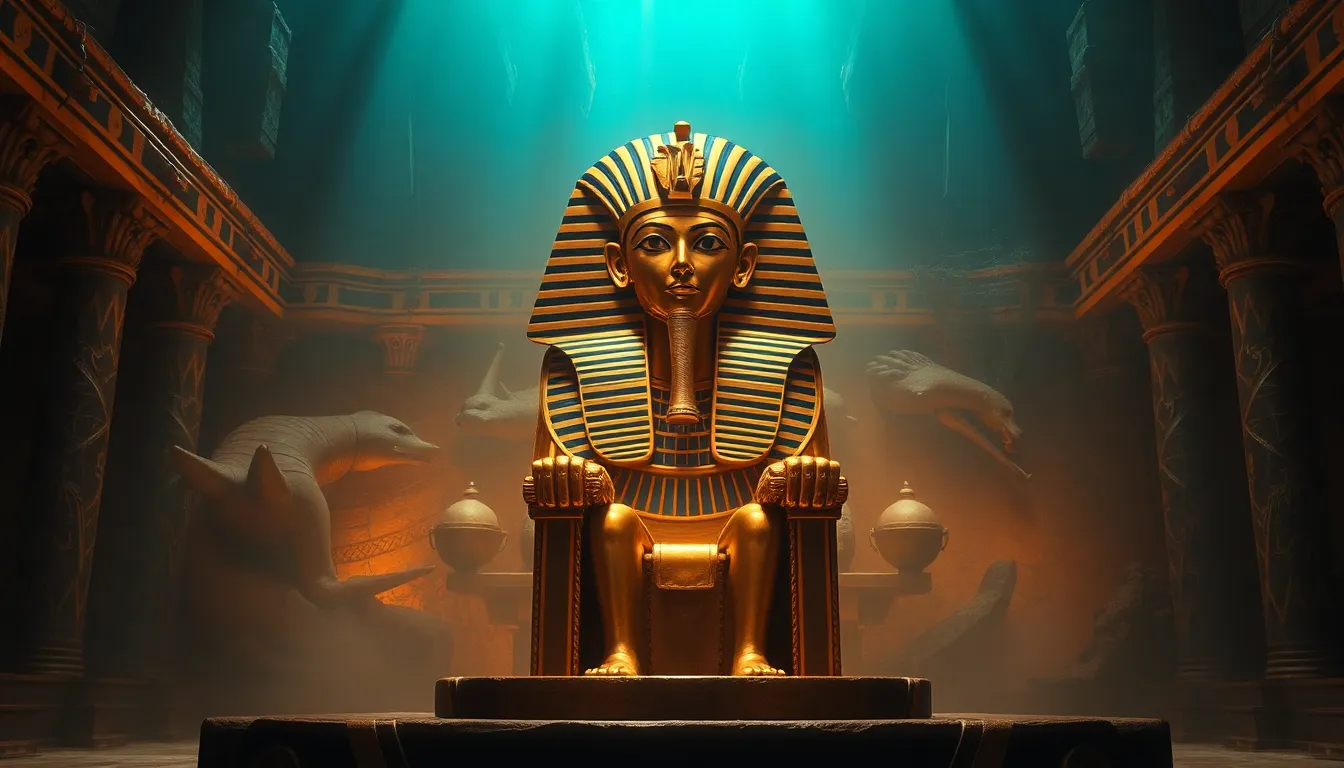The Myths of Pharaoh Tutankhamun’s Golden Throne
I. Introduction
Tutankhamun, often referred to as King Tut, is one of the most famous pharaohs of ancient Egypt, renowned for his opulent tomb and the treasures it contained. Ascending to the throne at a young age, he ruled during a time of significant change and restoration in ancient Egypt. His significance lies not only in his reign but also in the artifacts that have fascinated historians and the public alike.
Among these artifacts, the golden throne stands out as a symbol of royal power and ancient Egyptian artistry. Crafted with meticulous skill, it embodies the cultural and spiritual values of the time. This article aims to debunk common myths surrounding Tutankhamun’s golden throne, providing a clearer understanding of its historical and cultural relevance.
II. Historical Context of Tutankhamun’s Reign
Tutankhamun ascended to the throne around 1332 BC, during a tumultuous period in Egyptian history marked by religious and political upheaval. His reign, although brief, was crucial in restoring traditional polytheistic beliefs after the monotheistic experiment initiated by Akhenaten, his probable father.
The political climate was characterized by a struggle between competing factions, which influenced Tutankhamun’s decisions and actions. His reign is often viewed as a time of restoration and consolidation, which is reflected in the artifacts from his tomb.
Royal artifacts, such as thrones, were not merely symbols of authority; they played vital roles in ceremonies and daily governance, illustrating the divine right of pharaohs to rule.
III. Description of the Golden Throne
The golden throne of Tutankhamun is a masterpiece of ancient Egyptian craftsmanship. Made primarily of wood, it is covered with layers of gold leaf, giving it a striking appearance. The throne features intricate carvings and inlays, showcasing scenes that depict the young pharaoh in various divine and royal contexts.
Symbolically, the throne represents not only the power of the pharaoh but also the divine connection that rulers had with the gods. The motifs carved into the throne illustrate the important themes of life, death, and rebirth, central to Egyptian mythology.
- Materials Used: Wood, gold leaf, lapis lazuli, and other semi-precious stones.
- Design Features: A backrest decorated with images of Tutankhamun and his queen, Ankhesenamun, and lions’ heads representing strength and protection.
When compared to other royal thrones of the time, Tutankhamun’s throne is unique in its detailed craftsmanship and the combination of materials used, showcasing the wealth and artistry of the 18th Dynasty.
IV. Myth 1: The Throne Was Exclusively for Ceremonial Use
One prevalent myth about Tutankhamun’s throne is that it was used solely for ceremonial purposes. However, evidence suggests a more practical use.
Archaeological findings indicate that the throne was not only a ceremonial seat but also a functional piece of furniture in the royal palace. Artefacts and inscriptions found with the throne suggest it was used in daily activities, highlighting its significance beyond ceremonial occasions.
Insights from the tomb reveal that the throne was part of a larger set of furniture, indicating its use in everyday royal life.
V. Myth 2: The Throne Was Made Entirely of Gold
Another common misconception is that Tutankhamun’s throne was crafted entirely from gold. In reality, while gold leaf adorns the throne, it is primarily made of wood.
The use of gold leaf instead of solid gold served both aesthetic and economic purposes. It allowed the throne to have the luxurious appearance of gold while being more practical and less expensive to produce. This practice was common in ancient Egypt, where artisans often used gold leaf to embellish wooden furniture.
- Materials Breakdown:
- Wood: Core material for structure
- Gold Leaf: Decorative element
- Inlays: Semi-precious stones for added beauty
This choice of materials reflects the economic realities of the time while still showcasing the wealth of the pharaoh.
VI. Myth 3: The Throne Was Lost for Centuries
Many believe that Tutankhamun’s throne was lost for centuries before its discovery. In fact, the throne was never truly lost; it was part of the extensive burial goods found within his tomb, which remained undisturbed until their discovery in the early 20th century.
The throne was unearthed by the famed archaeologist Howard Carter in 1922, during his excavation of the nearly intact tomb in the Valley of the Kings. This find was groundbreaking, providing invaluable insight into ancient Egyptian burial practices and royal life.
The preservation of the throne and other artifacts was aided by the tomb’s protective seal, which kept it safe from looting and degradation for thousands of years, allowing Egyptologists to study it in its original context.
VII. Legacy and Influence of the Golden Throne
The legacy of Tutankhamun’s golden throne extends far beyond its physical presence. It has significantly shaped modern perceptions of ancient Egypt, symbolizing the opulence and mystique of the pharaonic era.
In contemporary culture, the throne’s imagery can be seen influencing various art forms, from paintings to fashion, reflecting a fascination with ancient aesthetics and symbolism.
Moreover, the throne plays a crucial role in museum exhibitions worldwide, serving as a focal point for discussions about ancient Egyptian culture and history. It has become emblematic of the treasures of Tutankhamun, drawing millions of visitors and igniting scholarly interest.
VIII. Conclusion
In conclusion, the myths surrounding Tutankhamun’s golden throne reveal much about our perceptions of ancient Egypt. By debunking these misconceptions, we gain a clearer understanding of the throne’s practical uses, its materials, and its historical context.
Accurate historical representation is essential for appreciating the complexity of ancient civilizations. Tutankhamun’s legacy continues to captivate the imagination, reminding us of the rich history and cultural depth of ancient Egypt.
The golden throne, with its intricate design and symbolic importance, remains a powerful testament to the artistry and beliefs of one of history’s most enigmatic pharaohs.




